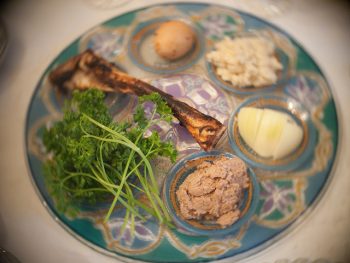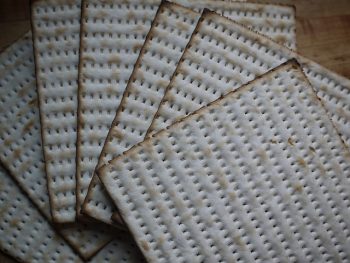Passover פֶּסַח Posted by Ayana on Apr 8, 2017 in Uncategorized
The most common question in Israel this month is: ‟Where are you celebrating Passover Seder (לֵיל הַסֵּדֶר)?”. Passover is an important Jewish festival. It’s a long holiday – seven days to be exact – and required a lot of preparations. לֵיל הַסֵּדֶר is its highlight. It’s a long evening filled in traditions, symbols and ceremonies. All for the sake of telling the account of the exodus from Egypt. No matter where you are celebrating it, you will always recognize these items and ceremonies. Take a deep breath, we begin.
The Haggadah הַגָּדָה שֶׁל פֶּסַח
The Jews were commanded not only to remember the day they have been freed from slavery, but also to pass it on to their children: ‟Then Moses said to the people: Remember this day on which you went out of Egypt, from the house of slavery, because with a mighty hand God brought you out of here… And you must tell your son on that day: It is because of what God did for me when I came out of Egypt”. (Exodus, chapter 13, verses 3-8).
In order to do so they wrote the הַגָּדָה – a Jewish text that includes prayers, poems, homiletic exegesis and sages’ commentary. It is unknown when exactly the current text of the הַגָּדָה formed, but parts of it were already written at the second century CE. The הַגָּדָה is composed of מׅצְווֹת לֵיל הַסֵּדֶר (Passover Seder’s commandments), and as such sets forth the order of the Passover Seder. The leader of the Seder (usually the host family’s father) is the one to conduct the evening by reading the הַגָּדָה, and by asking other participants to read out loud parts of the הַגָּדָה.
Seder plate קְעָרַת פֶּסַח
The Seder Plate has an important place on the table. It is a special plate, designed and decorated specially for לֵיל הַסֵּדֶר and containing all the important ingredients of the evening. The Seder plate is composed of six edible items that have special significance to the retelling of the story of the exodus: roasted lamb, Karpas, boiled egg, Hazeret, Haroset and Maror. A seventh symbolic item used during the meal — the three matzos — is not considered part of the Seder plate proper, but you can find it in the middle of the plate at some houses.
Salt water bowl קְעָרַת מֵי מֶלַח
A bowl of salt water is not traditionally part of the Seder Plate, but it’s placed on the table beside it. The salt water symbolizes the tears of the Jews who suffered the slavery in Egypt. The first thing to be eaten during לֵיל הַסֵּדֶר is the Karpas (a green vegetable). We dip the Karpas in the salt water so the kids will wonder about this custom and will ask for the purpose of this unusual way of eating. The answer they will be giving is the whole story of the exodus from Egypt.
Matzo מַצָּה
When the Jews left Egypt, they were in such a hurry that there was no time to wait for the dough to rise. They therefore ate matzos, unleavened bread. With that not-yet-done-bread, but with great faith, the Jews relied on God to provide the entire Jewish nation. Each year, to remember this, we eat matzos on פֶּסַח and fulfilling the Torah’s commandment, ‟Seven days you are to eat unleavened bread” [Exodus, chapter 12, verse 15].
On the Seder table we have three matzos. Two are traditional for Sabbath, when we usually use two loaves of bread. The third is divided before reading the הַגָּדָה. In the process of the evening, the leader of the סֵדֶר takes the middle matzo and breaks it in half. The large piece is wrapped and served as the Afikoman. The small piece stays at the table and eaten as the bread of affliction, as a meager bread.
Afikoman אֲפִיקוֹמָן
In the past, when the temple was still standing, the Jews used to sacrifice a lamb as a Passover sacrifice. They used to eat it as the last dish at Passover eve. Nowadays the Afikoman – that half of matzo – stands as a symbol to Passover sacrifice. As the lamb meat from the old days, so should the Afikoman be the last thing to be eaten during that evening. We eat a small piece from it at the end of לֵיל הַסֵּדֶר, and nothing else but water after it.
The purpose of לֵיל הַסֵּדֶר is to retell the children the story of the exodus. But the evening is exhausting, the הַגָּדָה is long, and the food is heavy. No wonder bored Jewish kids used to steal the Afikoman (which had been broken out from the middle matzo at the beginning of the evening) and hide it. Those bored (though smart) kids gave away the Afikoman (the last bite of the evening) in return for a present. This custom became a way to keep the kids awake. Nowadays it’s the parents who hide the Afikoman, and the kids stay up all evening to search it at the end of dinner.
Four glasses of wine אַרְבַּע כּוֹסוֹת יַיׅן
During לֵיל הַסֵּדֶר we drink four glasses of wine (or grape juice for the kids). The evening begins with Kiddush – a blessing recited over wine or grape juice to sanctify the Shabbat and the Jewish holidays. So the first glass of wine is part of the Kiddush, to welcome and receive the holiness of the holiday. We drink the second glass of wine during the process of reading the הַגָּדָה and telling the story of the exodus. The third glass is part of the Grace after Meals – a set of blessing following a meal that includes piece of bread or matzo. לֵיל הַסֵּדֶר ends with the fourth glass, which we drink after praising and thanking the Lord.
There many reasons for this particular number of glasses. The main explanation is that the promise of God to deliver the Jews from the Egyptian slavery included four terms to describe the redemption: ‟I will bring you out from under the yoke of the Egyptians. I will free you from being slaves to them and I will redeem you… I will take you as my own people” [Exodus, chapter 6, verses 6-7]. Drinking four glasses of wine during לֵיל הַסֵּדֶר shows that we put our trust in God who chose us as his nation and keeps redeem us ever since.
Elijah’s cup כּוֹס לְאֵלִיָּהוּ הַנָּבִיא
Two thousand years ago Jewish scholars discussed the necessity of drinking another glass of wine during לֵיל הַסֵּדֶר. Apparently for some people four glasses of wine is not enough! Those people read into the book of the Exodus, and found out the fifth path of the redemption: ‟And I will bring you into the land that I swore with an oath to give to Abraham, Isaac, and Jacob” [Exodus, chapter 6, verse 8]. Even today, Jewish scholars still doubt the full redemption, and therefore the fifth glass isn’t a must. Though it is still presents during לֵיל הַסֵּדֶר: it’s called Elijah’s cup. The solution for the disagreement of the scholars was to fill a fifth glass for Elijah the prophet. When he comes the redemption will be full.
Text vocabulary
Passover = פֶּסַח
Passover Seder = לֵיל הַסֵּדֶר
The Haggadah = הַגָּדָה שֶׁל פֶּסַח
Passover Seder’s commandments = מׅצְווֹת לֵיל הַסֵּדֶר
Plate = צַלַּחַת
Bowl = קְעָרָה
Seder plate = קְעָרַת פֶּסַח
Also called: צַלַּחַת פֶּסַח, קְעָרַת לֵיל הַסֵּדֶר etc.
Salt water = מֵי מֶלַח
Matzo = מַצָּה
Matzos = מַצּוֹת
Afikoman = אֲפִיקוֹמָן
Four glasses of wine = אַרְבַּע כּוֹסוֹת יַיׅן
Glass, cup = כּוֹס
Glasses = כּוֹסוֹת
Elijah’s cup = כּוֹס לְאֵלִיָּהוּ הַנָּבִיא
Prophet = נָבׅיא
Related posts:
Get Ready for Passover: the Seder Plate
Keep Calm and Learn Hebrew

Build vocabulary, practice pronunciation, and more with Transparent Language Online. Available anytime, anywhere, on any device.





